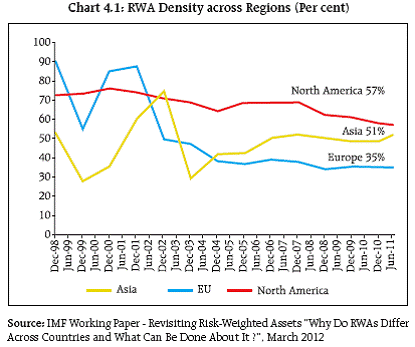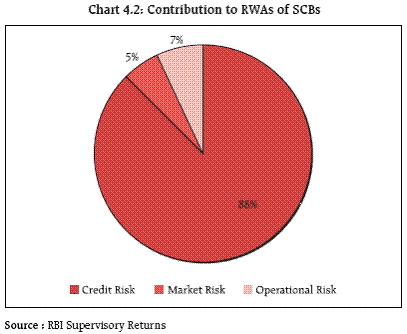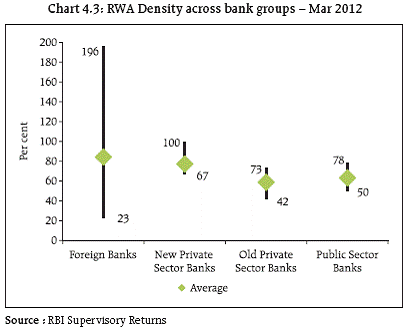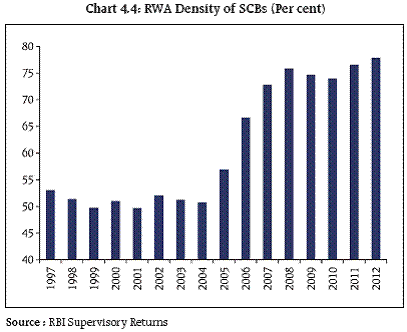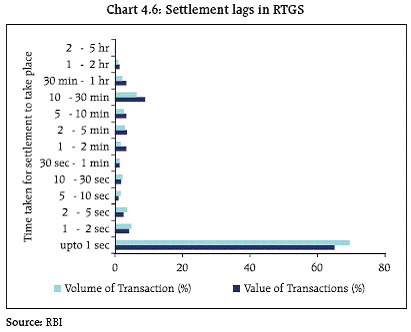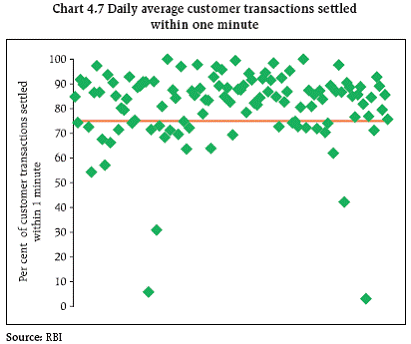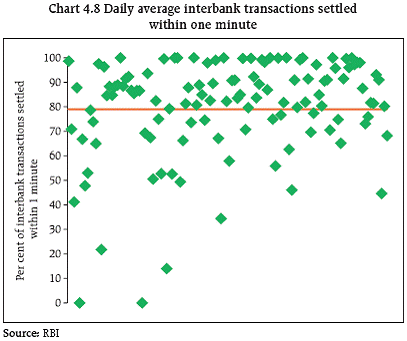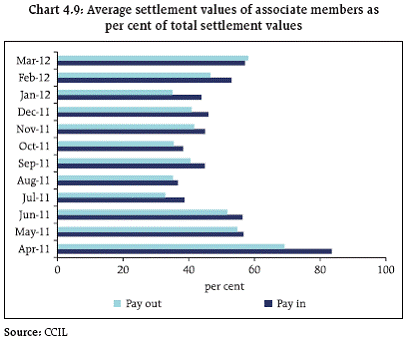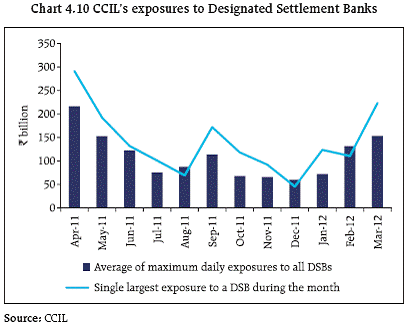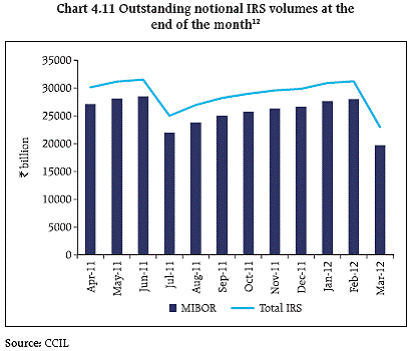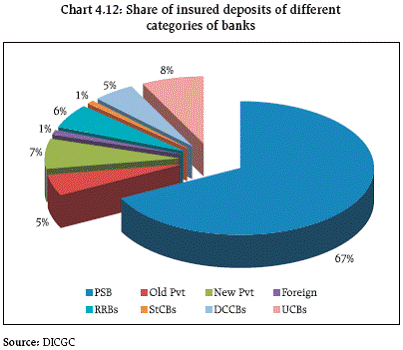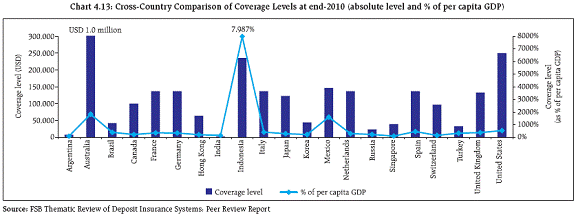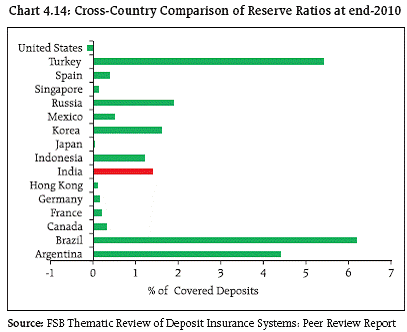 IST,
IST,
Chapter IV : Financial Sector Policies and Infrastructure
The financial sector reform measures initiated in the aftermath of the global financial crisis are being implemented by many countries, with the pace and extent of reforms varying across countries and markets. The standard setting bodies have come out with final recommendations for policy reforms, and these need to be implemented after extensive study and debate to ensure that adverse impact of unintended consequences do not outweigh the intended benefits. In the Indian context, final guidelines with respect to Basel III have been issued and a discussion paper on dynamic provisioning has been released. The unfinished agenda includes convergence with International Financial Reporting Standards (IFRS), strengthening the oversight mechanism of the non-banking financial sector, reforms in the Over the Counter (OTC) derivatives market and improving the resolution framework for financial institutions. The payment and settlement system in the country continues to be robust, with increasing use of electronic modes of settlement. Certain concerns, viz., settlement lags in the RTGS System and large uncollateralised intra-day exposures to settlement banks being assumed by the Clearing Corporation of India Limited (CCIL) need to be addressed. Safety net arrangements have functioned smoothly, but issues relating to the adequacy and resilience of the deposit insurance fund remain. Global regulatory reforms gathering pace, but implementation challenges will need to be addressed 4.1 International initiatives, started after the global financial crisis, have gathered momentum and the policy framework for the reforms has crystalised. However, several implementation challenges are emerging. 4.2 Several countries have announced their respective national policy frameworks for migration to Basel III leading to concerns about cross border consistency. Gaps in implementation are also emerging, for instance, with respect to putting in place resolution frameworks for systemically important financial institutions (SIFIs) and reforms in the OTC derivatives markets. Unintended consequences of the reform measures might pose challenges, especially to emerging markets such as India, which will need to be carefully monitored. One set of concerns relate to the potential deleveraging induced by the new capital and liquidity standards, affecting trade credit, infrastructure and project finance, etc. to emerging markets. There may not be a market in emerging economies for certain capital instruments, e.g. contingent capital instruments, which are being proposed under Basel III. There are also concerns about the availability of a sufficient quantum of ‘liquid’ assets prescribed under the Basel III liquidity norms and the impact of such requirements on domestic financial markets. Guidelines reflecting the new international standards have been issued 4.3 The Reserve Bank, on May 2, 2012, issued final guidelines on Basel III. The implementation of Basel III capital requirements will begin on January 1, 2013. The norms will be fully implemented by March 31, 20181. Under the new standards, banks will have to
4.4 As a prudential measure, the existing capital adequacy requirement in India is one per cent higher than the minimum prescribed by the Basel Committee, and the higher requirement will continue under Basel III. A more stringent leverage ratio has also been prescribed based on the fact that most Indian banks have a relatively comfortable leverage position, much more than the minimum of 3 per cent proposed by the Basel Committee. During the period of parallel run, banks should strive to maintain their existing level of leverage ratio but, in no case the leverage ratio should fall below 4.5 per cent. A bank whose leverage ratio is below 4.5 per cent may endeavour to bring it above 4.5 per cent as early as possible. Final leverage ratio requirements will be prescribed by the Reserve Bank after the parallel run, taking into account the prescriptions given by the Basel Committee. 4.5 The implementation of Basel III proposals are expected to be far reaching. For emerging economies like India, the implementation comes at a time when credit demand is expected to pick up, given the compulsions of growth; the investment needs of infrastructure; and the demand ushered in by increasing financial inclusion. Simultaneously meeting the requirements of additional capital buffers and the growing credit needs of the economy may pose challenges. As the additional capital requirements, both equity and non-equity, are likely to increase over the period of full implementation of Basel III, this could put pressure on capital markets, increase the cost of capital and reduce return on equity, in the short-term for the banking system. The fiscal impact of the increased capital requirements of public sector banks has also to be reckoned with. However, in the medium to long term, the measures are expected to yield net benefit to the banking system and to the economy at large. Also, the comfortable capital adequacy position of banks in India (CRAR at over 14 per cent and core CRAR at over 10 per cent as on March 31, 2012) under Basel II implies that banks will migrate to the Basel III requirements from a position of relative strength. The extended transitional arrangement for full implementation of Basel III provides sufficient time to banks to carefully assess and raise the capital required. 4.6 The case for prescribing forward looking provisions for credit risk for Indian banks was highlighted in the previous FSR. The Reserve Bank has since issued draft guidelines on dynamic provisioning2. The dynamic provision created during a year has been quantifi ed as the difference between long run average expected loss (EL) of the portfolio for one year and the incremental specific provisions made during the year (Box 4.1). Progress in convergence with IFRS has been tardy 4.7 Challenges to the IFRS convergence of the banking sector arise from a lack of clarity about the convergence schedule domestically, as also from the uncertainity in the finalisation of IFRS 9 relating to Financial Instruments. The uncertainties with respect to IFRS 9 arise, on account of delays in finalising the proposals relating to impairment and hedge accounting by the International Accounting Standards Board (IASB) coupled with recent proposals by IASB to reopen previously finalised requirements relating to classification and measurement of financial assets. There are also some major technical issues arising for Indian banks in the course of convergence. Differences between the IFRS and current regulatory guidelines on classification and measurement of financial assets, focus in the standard on the business model followed by banks and the challenges for management in this area, lack of adequate number of skilled staff and modifications to IT systems and processes are some of the other challenges that may need to be tackled in due course. As discussed in previous FSRs, a Working Group constituted by the Reserve Bank is examining the implementation issues. The existing resolution regime in the country may need a revamp 4.8 The extant rules for resolution do not meet all the requirements of the Key Attributes of Effective Resolution Regimes for Financial Institutions adopted by the Financial Stability Board (FSB)3. In India, there is no explicit governance arrangement for resolution in the form of legal and institutional structures. At present, resolution of a bank is attempted under the Banking Regulation (BR) Act, 1949, through compulsory or voluntary mergers. One of the fundamental objectives of any resolution attempt is to protect the interests of the depositors. However, in the case of compulsory amalgamation under section 45 of the BR Act, 1949, shareholders are not completely precluded from getting compensation. Box 4.1: Introduction of Dynamic Loan Loss Provisioning Framework for Banks in India Indian banks make four types of loan loss provisions at present, viz., (a) general provisions for standard assets; (b) specific provisions for non performing assets (NPAs); (c) floating provisions; and (d) provisions against the diminution in the fair value of a restructured asset. The present provisioning policy was found to have the following drawbacks, (i) the rate of standard asset provisions has not been determined based on any scientific analysis or the credit loss history of banks; (ii) banks make floating provisions at their discretion without any pre-determined rules and not all banks make floating provisions; (iii) though the Reserve Bank has been following a policy of countercyclical variation of standard asset provisioning rates, the methodology has been largely based on current available data and judgement, rather than on an analysis of credit cycles and loss history, and hence the provisioning framework does not have countercyclical or cycle smoothening elements. Advances in credit risk modeling over the last decade or so have introduced the concept of expected losses (EL) and unexpected losses (UL) to measure potential losses in a credit portfolio. It is generally accepted that banks should cover the unexpected losses by capital and expected losses by provisions. The EL is generally derived as the mean of the credit loss distribution. EL-based provisioning has forward-looking elements as it is capable of incorporating a through-the-cycle view of the probability of default. The Basel Committee also supports an EL approach that captures actual losses more transparently and is also less procyclical than the current ‘incurred loss’ approach. The objective of the dynamic provisioning framework is to smoothen the impact of incurred losses on profits through the cycle, and not to provide general provisioning cushion for expected losses. The proposed dynamic provisioning framework in India consists of two components, viz., a. Ex-post specific provisions (SP) made during a year (which will be debited to the profit and loss account), required as per RBI guidelines; and b. Dynamic provisions (DP) equal to αCt – ΔSP i.e., the difference between the long run average expected loss of the portfolio for one year and the incremental specific provisions made during the year (α represents EL and Ct represents stock of loans). It is assumed that when the approach is implemented for the first time, the bank will have adequate SP to cover its NPAs. Positive value of αCt - ΔSP will increase the credit balance in DP Account. A negative value will represent a drawdown from the DP Account. This will generally ensure that every year the charge to profit and loss on account of specific provisions and DP is maintained at a level of αCt. With respect to the implementation of a dynamic provisioning framework, not all banks can be expected to be on the same plane. Banks with available capability can introduce a DP framework based on the theoretical model, while the other banks can follow the standardised method, which is outlined in the draft guidelines. Internal estimates based on the data obtained from a sample of banks reveal that in terms of impact on the profit and loss of banks, the approach would mean taking a total provisioning charge to profit and loss account equivalent to 1.37 per cent of the gross advances annually. Supervisory data show that during the period from 2003 to 2010, average annual charge to profit and loss on account of standard asset provisions and specific provisions gross of write-offs amounted to 1.04 per cent of gross advances, in the range of 0.58 per cent to 1.87 per cent of the gross advances. The additional charge is mainly attributed to calibration of α based on downturn Loss Given Default (LGD). Regulation (BR) Act, 1949, through compulsory or voluntary mergers. One of the fundamental objectives of any resolution attempt is to protect the interests of the depositors. However, in the case of compulsory amalgamation under section 45 of the BR Act, 1949, shareholders are not completely precluded from getting compensation. 4.9 In order to examine the gaps in the extant resolution regime for financial institutions in India visà- vis the ‘key attributes’ and to suggest the nature and extent of the legislative and regulatory changes needed to address such gaps, a Working Group has been constituted in the Reserve Bank. The Sub Committee of the Financial Stability and Development Council (FSDC) is also deliberating on the issue. Differences in RWA density could be accentuated as banks migrate to the Basel II advanced approaches 4.10 From a stability perspective, migration of banks, particularly large banks with international presence, to the advanced approaches under Basel II is desirable. When the banks migrate to these approaches, trends in RWAs will need to be monitored. 4.11 Capital ratios are key indicators of a bank’s solvency and resilience. RWAs are key to the computation of capital ratios of banks with the proportion of RWAs to Total Assets (RWA density) serving as an indicator of a bank’s riskiness. However, significant differences in the RWA density are observed across jurisdictions (Chart 4.1). Such differences are also observed across banks in the same jurisdiction. For the most part, the differences in RWA density are risk-based i.e. they reflect the differences in the riskiness of the underlying portfolio and of the bank’s business mix. Variations also arise due to differences in the stage of regulatory evolution – Basel I, Basel II, rollout of the advances approaches, etc. and use of national discretion in this regard. Concerns, however, emerge in respect of the variations which arise due to differences in interpretation of the standards and lead to practice-based inconsistencies in the calibration of risk parameters. 4.12 In the Indian context, credit risk is by far the largest component of RWAs representing, on an average, 71 per cent of total RWAs for the banking sector (Chart 4.2). There are, however, significant differences in the RWA density across banks, though for the scheduled commercial banks (SCBs) as a whole, RWA density has been increasing over time (Charts 4.3 and 4.4). …leading to potential diminishing trust in capital ratios 4.13 The gradual shift from Basel I to Basel II and to the Internal Rating Based approaches has enabled banks to benefit to some extent from lower RWAs. Perceived differences in RWAs within and across countries have, however, raised questions about the reliability of RWAs and capital ratios. 4.14 The Basel Committee, as part of its comprehensive monitoring of the implementation of Basel III, has proposed, inter alia, to identify areas of material inconsistencies in the calculation of RWAs. The findings of the exercise could result in policy recommendations to address the identified inconsistencies. Closer monitoring of banks’ interaction with Non Banking Financial Companies (NBFCs) and Mutual Funds is warranted... 4.15 International efforts at strengthening the oversight and regulation of shadow banking activities continue. The challenge in regulating this segment is to ensure that all significant players are brought under regulation, while ensuring that there are no incentives to migrate to the less stringently regulated segments. The policy reforms are presently focusing on five key areas, viz., (a) mitigation of the spill-over effect between the regular banking system and the shadow banking system; (b) reducing the susceptibility of money market funds to ‘runs’; (c) assessing and mitigating systemic risks posed by other shadow banking entities; (d) assessing and aligning the incentives associated with securitisation; and (e) dampening risks and pro-cyclical incentives associated with secured financing contracts such as repos, and securities lending that may exacerbate funding strains in times of ‘runs’4. ... given the interconnectedness between different segments of the financial system 4.16 The non banking financial sector in the country comprising, inter alia, NBFCs, mutual funds and insurance companies, functions within a regulatory framework appropriate to the activities undertaken by these entities. Nonetheless, a complete macro mapping of all kinds of credit intermediation activities would be warranted in the light of international reforms in this area. Further, there are concerns posed by the degree of interconnectedness of these entities with the banking system which could pose credit and liquidity risks (Chapter V). 4.17 Some concerns are also posed by the degree of reliance of the mutual funds sector, especially the Money Market Mutual Funds, on institutional investors. In times of stress, withdrawal of funds by such investors could pose severe liquidity strains, as was observed in 2008-2009. Regulatory gaps being identified and plugged… 4.18 Gaps in the regulation of the non banking financial sector are being continuously identified and plugged and the oversight mechanism strengthened. The need for a regulatory framework for Alternative Investment (AI) Funds, which had been flagged in previous FSRs, was discussed by FSDC Sub Committee, and the Securities and Exchange Board of India (SEBI) has since put in place a framework for the same. In cognition of the risks posed to the banking system on account of their exposure to NBFCs extending gold loans, exposure limits of banks to NBFCs have been tightened while loan to value (LTV) ratios have been prescribed on gold loans extended by NBFCs. Similar LTV ratios have not been prescribed for the banking system and this may necessitate a relook, going forward. Global initiatives for systemically important insurance companies may not affect Indian companies… 4.19 The International Association of Insurance Supervisors (IAIS), in conjunction with FSB, is in the process of developing a methodology to assess the systemic importance of insurers. The methodology will take congisance of the nature of insurance activities and the risks posed to the stability of the financial system. It is likely to include a range of parameters including nature of operations of the entity, its size, interconnectedness and substitutability, and its global activity. The IAIS is in the process of collating and analysing data in this regard. The Life Insurance Corporation of India participated in the first phase of this exercise. However, only some of the indicators being considered by the IAIS may be relevant in the Indian context given the nature of insurance operations in India and the extant regulatory framework. Further, the level of global operations of Indian companies is limited and their exposure to complex financial products almost non-existent. Potential mis-selling under the Bancassurance model will need to be addressed 4.20 Bancassurance refers to the insurance distribution model where insurance products are sold through the bank branch network. The model has acquired popularity in the Indian context as many large banking groups in the country are also promoters of insurance companies. Further, the geographical reach of banks has made them ideal vehicles for the distribution of insurance products. Instances of mis-selling of insurance products through this delivery channel have been evidenced, though there are extant regulatory requirements mandating that bank staff handling the sale of insurance products be adequately trained. There is also some anecdotal evidence of insurance products being sold as a ‘package’ along with banking products such as deposits and loans, raising issues of conflict of interest. The proposed regulations on Investment Advisors by SEBI and on Bancassurance by the Insurance Regulatory and Development Authority (IRDA) are likely to address the issue. Concerted efforts to educate customers in this regard will also be necessary. Financial Market Infrastructure (FMI) The country’s FMI functioned smoothly despite heightened market volatility 4.21 The payment and settlement systems in the country remained robust and continued to function without any major disruption. The FMI displayed a significant degree of resilience, with central counterparties in different segments managing the impact of heightened volatility in various markets, including the foreign exchange markets (Box 4.2). Liberalisation of access criteria provided a fillip to electronic payment systems 4.22 The shift towards electronic modes of settlement continued, with the value of transactions settled through the Real Time Gross Settlement (RTGS) system accounting for over 74 per cent of total settlement values as at end March 2012. Volume wise, the share of retail electronic transactions grew from 37 per cent in March 2011 to about 45 per cent in March 2012. Box 4.2: Increased volatility in the foreign exchange market and CCIL’s US$/INR settlement The year 2011-12, and especially the period under review, witnessed heightened volatility (Chapter 2). The increased volatility and the sharp depreciation in the value of the Indian rupee resulted in significant changes in the marked to market (MTM) margin liability of the members of CCIL’s forex segment, with the impact depending on the net currency positions of the participants. Managing the risks necessitated increase in initial margins and, in also in some instances of increase in variation margins. On a few occasions, heightened intraday volatility resulted in the margin cover being reduced by more than 50 per cent warranting the collection of intraday MTM margins (Table 4.1 and Chart 4.5).
4.23 The migration of payment transactions to RTGS and National Electronic Fund Transfer (NEFT) settlement modes is likely to gain impetus from the liberalisation of access criteria to electronic payment systems5. So far, the centralised electronic payment systems provided for only direct membership. The sub-membership route has been enabled for all licensed banks to participate in NEFT and RTGS systems. Such sub-membership would be an alternate mechanism to licensed banks which have the technological capabilities but are not participating in centralised payment systems on account of access criteria or cost considerations. Risks minimised in RTGS… but efficacy of intraday liquidity management varies across participants 4.24 RTGS systems permit transactions to be settled deal by deal and in real time, thus attempting to eliminate systemic and settlement risks. Specifically, RTGS can substantially contribute to the reduction in the duration of credit and liquidity exposures in payment and settlement systems. In the Indian context, an empirical analysis of the settlement lags in the RTGS6 reveals that 70 per cent of average daily transactions (constituting 65 per cent of the average daily settlement amount) are settled instantaneously (Chart 4.6). This is facilitated by proactive intraday liquidity management by banks7, provision of intraday liquidity by the central bank and the ‘double duty’ performed by prudential reserve balances maintained by banks. Nevertheless, nearly 25 per cent of transactions (by amount) are settled with a lag of more than one minute while 15 per cent are settled with a lag of more than 10 minutes. There are also large variations observed with respect to settlement lags amongst different participants of the RTGS system. The underlying trends, especially with regard to the outliers will need to be carefully monitored (Charts 4.7 and 4.8). Designated settlement banks (DSBs) of CCIL act as quasi payment systems…. 4.25 Quasi-payment systems are generally defined as “Commercial institutions responsible for clearing and settling payments on behalf of customers which represent, by value, a substantial percentage of payments …. being settled across the books of the institution rather than through an organised payment system”.8 Risks posed by such institutions are similar to those posed by systemically important payment systems. 4.26 The risks arising from the concentration of associate members in the Collateralised Borrowing and Lending Obligation (CBLO) and securities segments of CCIL in two DSBs were highlighted in the FSR of December 2011. The risks are exacerbated by the fact that the DSBs themselves are large participants (with proprietary positions) in most market segments. An analysis of the settlement volumes indicates that associate members account for a significant proportion of the settlement volumes (Chart 4.9). The DSBs, thus, act as quasi payment settlement systems and the risks they pose to the overall system will need to be monitored. ….necessitating CCIL to assume large intraday exposures to the DSBs 4.27 The large settlement values of the associate members result in CCIL assuming significant intraday exposures to the DSBs (on account of the pay-in made by the associate members to the DSB) (Chart 4.10). CCIL has sanctioned limits for each of the DSBs, which are uncollateralised. There are also instances of exposure to the DSBs being in excess of the limits. Failure of one or more DSBs could pose systemic concerns and the trends in this regard need to be assessed vis-à-vis CCIL’s financial resources, its liquidity and credit risk management framework and extant regulatory prescriptions on the capital adequacy norms for banks’ exposures to central counterparties (CCPs)9. The Basel Committee is also working on the issues related to the appropriate capitalisation of banks’ exposure to CCPs. At present, exposures to CCPs under Basel II attract zero exposure value. 4.28 Available evidence suggests that the DSBs, in turn, extend intraday liquidity to the associate members including equity market players. If the associated risks are not rigorously managed by the DSBs, they could further exacerbate the risks faced by the CCP. Going forward, however, the Basel III liquidity risk framework, which incorporates effective management of intraday liquidity, may alleviate these risks. OTC Derivative markets Delays in implementing OTC derivative market reforms observed internationally 4.29 Several issues and challenges facing the OTC markets in India, viz., skewed participation structure, need for greater standardisation, introduction of central clearing, etc., were highlighted in previous FSRs. Even as these issues remain relevant, challenges are posed by the international reforms agenda for OTC derivatives viz., “all standardised OTC derivative contracts be traded on exchanges or electronic trading platforms, where appropriate, and cleared through central counterparties by end-2012”. The FSB has observed delays in both rule making and implementation of the reform process across G20 jurisdictions. Certain exceptions for some derivative products, e.g. foreign exchange forwards, are, however, under consideration. 4.30 In the case of India, the market for OTC derivatives has developed in a calibrated manner along with, in most cases, a concomitant regulatory framework. CCP arrangements already exist in the country for foreign exchange forward contracts involving the domestic currency. Similar arrangements are being contemplated for other products. However, markets such as that for Credit Defaults Swaps are in a nascent stage and extant volumes do not warrant centralised settlements. The existing reporting arrangements for OTC derivatives encompass foreign exchange, interest rate, government securities, corporate bonds and money market instruments and are being strengthened, as was discussed in previous FSRs. Going forward, the key priority for Indian markets would be greater standardisation of OTC products, introduction of central clearing arrangements for a greater number of such products and reporting of all OTC trades to the trade repository. Volumes in the Interest Rate Swap (IRS) market in India could warrant centralised settlement…. 4.31 Low volumes in some derivative markets make it challenging to introduce guaranteed clearing for such products. A recent Bank of England report10, which attempts to construct a definition for “central clearing eligibility” of a product, observed that liquidity is a key determinant in a central counterparty’s decision to clear a product and that the systemic risk reduction benefits of central clearing can be achieved only when contracts meet this eligibility criteria. 4.32 In the Indian context, IRS, launched in 1999, is the only OTC derivative product where the market volumes have grown substantially. The growth has been particularly marked in the case of the overnight index swap based on the overnight money market index (Chart 4.11). The participation structure in the market, however, remains skewed with foreign banks dominating the IRS market11. …but will necessitate robust risk management by the CCP and potentially onerous margin requirements 4.33 Central clearing of IRS trades will shift the primary responsibility of managing counterparty risks to the CCP. It is, thus, critical that the CCP has adequate financial resources and exercises effective risk control. The CCP will need to, inter alia, design margin and other risk management requirements which account for the complexity of the underlying instruments and maintain sufficient liquid resources to ensure settlement under a wide range of potential stress scenarios. Further, the overall cost to participants of central clearing of derivative transactions will need to be assessed as margin requirements could be very high for some banks during volatile times. As all positions will need to be collateralised, shifting IRS transactions to a CCP could entail large collateral requirements. 4.34 The concentration risks arising from the gamut of activities carried out by CCIL have been flagged in previous FSRs. Additionally, entrusting the responsibility of centralised clearing of IRS trades or any other OTC derivative trades to CCIL could add to these risks and will have to be contingent on a thorough assessment of its ability and financial resources, including liquidity resources, to handle extreme market situations. Bilateral margins for OTC derivatives may have systemic implications 4.35 Migration of all OTC derivative contracts to central clearing will be challenging and may also not be desirable as OTC products can perform a valuable function of offering customised contracts to suit individual hedging requirements. These contracts, however, will continue to engender counterparty and systemic risks. Bilateral margins on non-centrally cleared products are, thus, being contemplated internationally to reduce the systemic risks arising from such products and for creating incentives for centralised clearing. Such margins may need to be considered in the Indian context also, after weighing the advantages against the systemic implications of the increased collateral requirements. The potential benefits of margin requirements could be partially offset by the impact arising from the need to provide high-quality, liquid collateral, especially at a time when the Basel III liquidity requirements will create additional demand for similar securities. IMF’s recent Global Financial Stability Report (April 2012) has also highlighted that “heightened uncertainty, regulatory reforms and the extraordinary post-crisis responses of central banks in the advanced economies have been driving up demand for safe assets… even as the supply of such assets has contracted,… with negative implications for global financial stability”. New and demanding international standards issued for FMIs…… 4.36 New international standards for payment, clearing and settlement systems were issued in April 2012 by the Committee on Payment and Settlement Systems (CPSS) and the Technical Committee of the International Organization of Securities Commissions (IOSCO)13. The new standards (called “principles”) will be applicable to all systemically important payment systems, central securities depositories, securities settlement systems, central counterparties and trade repositories (collectively “financial market infrastructures” or “FMIs”). The set of 24 principles is designed to ensure that the essential infrastructure supporting global financial markets is robust and better placed to withstand financial shocks. They encompass issues related to the legal basis and the governance framework of the FMI, its credit, liquidity and operational risk management framework, settlement systems, default management, access criteria and the efficiency and transparency of FMI’s. …necessitating assessment of compliance of domestic FMIs with the Principles 4.37 Compared with the current standards, the new principles pose more stringent requirements in important areas like financial resources and risk management procedures of an FMI, default handing and the mitigation of business and operational risk. In the Indian context, previous formal assessments observed the country’s FMIs to be broadly compliant with the then prevalent international standards e.g. the Core Principles for Systemically Important Payment Systems, Recommendations for Securities Settlement Systems and Risk Management Principles for Central Counterparties. Going forward, the degree to which domestic FMIs observe the new principles will need to be evaluated. Legal amendments will be necessary to ensure orderly handling of a FMI default 4.38 Given the criticality of the functioning of FMIs, the risks which FMIs can pose to financial stability in the event of a default, warrants that an effective resolution mechanism be put in place to ensure orderly winding up of such entities. The FSB’s Key Attributes of Effective Resolution Regimes for financial institutions14 are also applicable for FMIs. 4.39 In the Indian context, currently, there is no provision in the RBI Act, 1934, or the Payment and Settlement System (PSS) Act, 2007, which enable the recapitalisation, orderly winding up or reorganisation of FMIs regulated by the Reserve Bank. In the absence of a specific legal mandate, the insolvency proceedings as laid down under the general law would be applicable. Compliance with the Key Attributes would necessitate that the Reserve Bank is conferred with adequate powers for effective resolution of the FMIs regulated by it, such as CCPs and payment systems through appropriate amendments to the PSS Act. Safety net arrangements The Coverage and Reserve Ratio of the deposit insurance fund remains low… 4.40 In India, deposit insurance is mandatory for all banks. Deposit insurance is provided by the Deposit Insurance and Credit Guarantee Corporation (DICGC), a wholly owned subsidiary of the Reserve Bank of India (Chart 4.12).15 The coverage levels of the deposit insurance in India, both in terms of absolute amount and as a percentage of per capita GDP, remain low as compared to international standards (Chart 4.13). The Reserve Ratio (ratio of fund balance to insured deposits), which stood at 1.4 per cent as at end March 2012, is also low as compared to peer emerging market economies, though a target reserve ratio has not been prescribed for India (Chart 4.14). …. Necessitating exploring options to strengthen DICGC’s fund base 4.41 Bank failures in the Indian context have typically taken place in the case of banks in the co-operative sector. DICGC’s fund, as per current coverage levels, may not be adequate in the event of a large bank failing. Several options, for instance, income and service tax exemption for the Corporation, hiking the premium charged, provision for emergency liquidity support, etc. may need to be explored with a view to strengthening the fund. FSB Peer review of deposit insurance systems throw up several lessons for DICGC 4.42 The FSB recently undertook a peer review of deposit insurance systems16 among its member institutions based on the Basel Committee on Banking Supervision – International Association of Deposit Insurers (BCBS-IADI) Core Principle for Effective Deposit Insurance Systems. Several recommendations of the peer review report are particularly relevant for India and will need to be carefully examined. These include: i. review of coverage levels to ensure that it strikes an appropriate balance between depositor protection and market discipline; ii. prompt depositor reimbursement in situations when payout is the only choice to deal with a bank failure; this needs to be supported by comprehensive and prompt access to bank data, early information access via a single customer view, and robust information technology infrastructure; iii. strengthening the degree of coordination between the deposit insurance agency and other safety net players to ensure effective resolution planning and prompt depositor payment; and iv. unambiguous and immediate access to reliable funding sources (including any back-up funding options) to meet the financing requirements. 1 Implementation has been advanced by nine months to make full implementation co-terminus with the financial closure of banks on March 31 of every year. 2 RBI Discussion paper on “Introduction of Dynamic Provisioning Framework for Bank in India”, March 30, 2012 3 http://www.financialstabilityboard.org/publications/r_111104cc.pdf 4 http://www.financialstabilityboard.org/press/pr_111027.pdf 5 /en/web/rbi/-/notifications/access-criteria-for-payment-systems-sub-membership-to-centralised-payment-systems-7113 6 The empirical analysis used individual transaction data from the RTGS for 15 working days in the month of March 2012. 7 Several large participants of RTGS have procured intraday liquidity management systems which enables them to manage payment queues internally. 8 “Central bank oversight of payment and settlement systems”, BIS, May 2005 9 The exposures to CCPs on account of derivatives trading and securities financing transactions (e.g. CBLOs, Repos) outstanding against them, are currently assigned zero exposure value for counterparty credit risk, as it is presumed that the CCPs’ exposures to their counterparties are fully collateralised on a daily basis, thereby providing protection for the CCP’s credit risk exposures. Deposits / collateral kept by banks with CCIL, however, attract 20 per cent risk weight. (/en/web/rbi/-/notifications/capital-adequacy-norms-for-banks-exposures-to-central-counterparties-ccps-5001). 10 “Thoughts on determining central clearing eligibility of OTC derivatives”, Bank of England, Financial Stability Paper No. 14, CheSidanius and Anne Wetherilt, March 2012 11 Financial Stability Report, (December 2010, Paragraphs 3.48) includes an analysis of concentration risks posed by OTC derivatives market in India (/en/web/rbi/-/press-releases/india-s-financial-sector-remained-stress-free-but-risks-arising-from-macro-economic-soft-spots-and-global-growth-asymmetries-remain-rbi-s-second-financial-stability-report-23666) 12 The sudden dip in volume observed in March 2012 is largely due to reduction in notional positions as a result of trade compression introduced by CCIL recently, as was discussed in previous FSRs. 13 Principles for financial market infrastructures, April 2012 (http://www.bis.org/publ/cpss101.htm) 14 http://www.fi nancialstabilityboard.org/publications/r_111104cc.pdf 15 See Financial Stability Report, Issue No. 1, March 2010 for a complete description of the coverage of deposit insurance in India 16 http://www.financialstabilityboard.org/press/pr_120208.pdf |
||||||||||||||||||||||||
পৃষ্ঠাটো শেহতীয়া আপডেট কৰা তাৰিখ:






